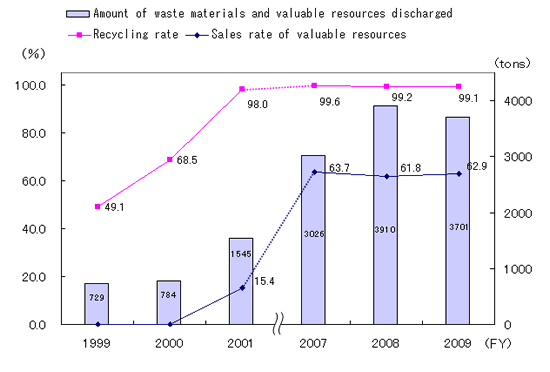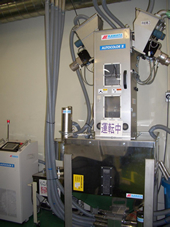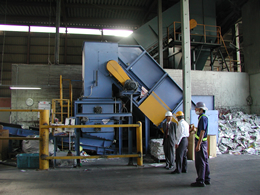Environmental Report 2010
Zero Emissions
Specifically, it effectively uses resources and promotes recycling and sales of valuable resources through the exhaustive sorting of waste, such as scrap plastic and metal.Zero Emissions Activities
After launching its zero emissions efforts in FY 2000, JAE achieved a recycling rate of 95% in FY 2001 and 99% in 2004, and kept it at the 99% level thereafter.The sales rate of all valuable resources exceeded 60% in FY 2006, and it remained at 60% or higher thereafter. In FY 2008, however, some waste plastic could not be sold from November onward due to the effects of the global economic downturn. This situation is expected to gradually improve as time goes by, but efforts must be made to improve the sales rate.
Note: The JAE Group defines zero emissions as achieving a recycling rate of 99% or higher for waste defined by local ordinances, excluding waste that is disposed of by incineration and simple landfills.
Change in Waste Treatment

(Note: Valuable resources are not included in the FY 1999 and 2000 figures.)
Main Activities in FY 2009
- Improving sales rate of valuable waste plastics (JAE, HAE)
The sales rate is being improved through various efforts, including fixing operational issues with recycling firms and thoroughly recovering waste plastic by type from molding waste.
- Recycling molding waste (HAE)
Crushing sprue runners and mixing it at a certain percentage with virgin material so that it can be used for non-product sections of some products is contributing to a reduction in the amount of material used and the molding waste that has to be disposed - Recycling cleaning fluids (YAE)
Some cleaning fluids that had been used were distilled for reuse, thereby cutting the volume of waste generated. And for other cleaning fluids, waste was curtailed by selling those that had been used but could still be considered valuable.

Efforts for Proper Disposal of Waste Materials
The JAE Group is implementing proper disposal of waste materials in accordance with Japan's Waste Disposal Law. The group conducts compliance studies on waste-disposal subcontractors at the time of contract signing and periodically thereafter by periodically checking their licenses and performing on-site inspections.
The group also is improving the reliability of its operations and management by regulating and strictly enforcing the use of industrial waste manifests and by building a waste emission system in FY 2004. Starting in FY 2010, the group is striving to introduce electronic manifests.
